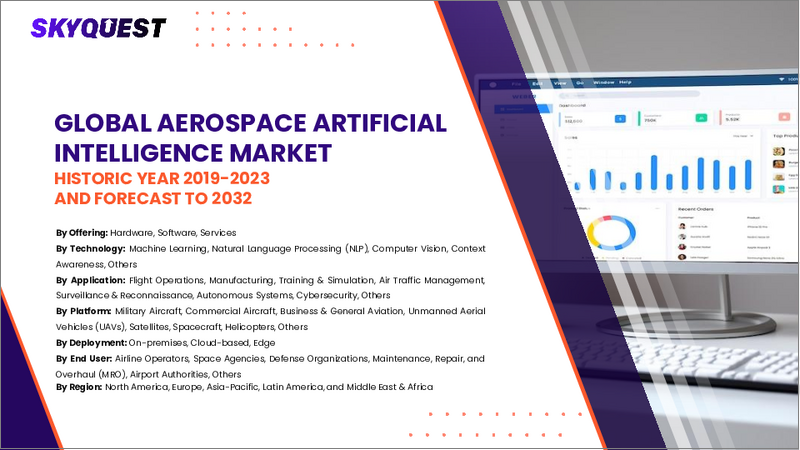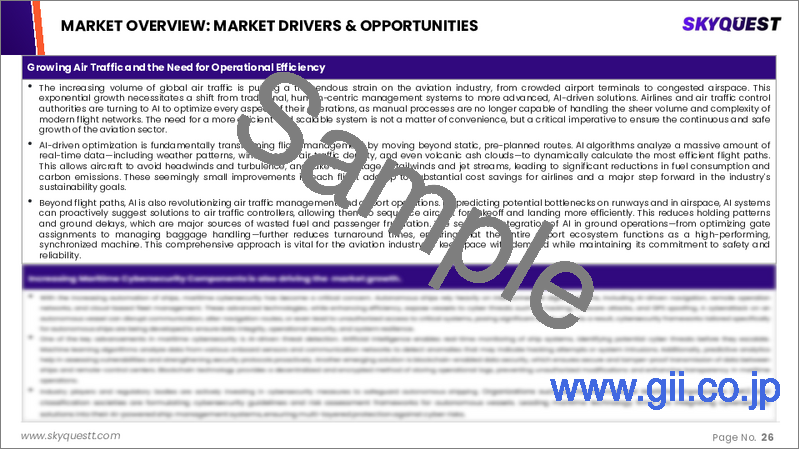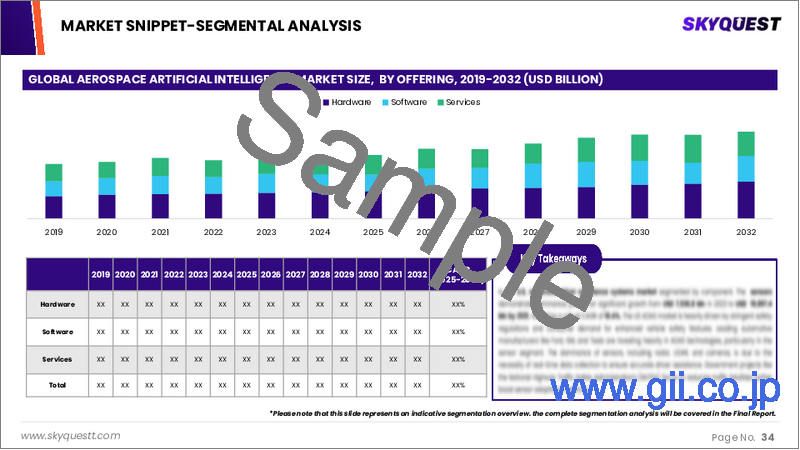|
|
市場調査レポート
商品コード
1755508
航空宇宙向け人工知能の市場規模、シェア、成長分析、提供別、技術別、用途別、地域別 - 産業予測、2025年~2032年Aerospace Artificial Intelligence Market Size, Share, and Growth Analysis, By Offering (Software, Hardware), By Technology (Machine Learning, Natural Language Processing), By Applications, By Region - Industry Forecast 2025-2032 |
||||||
|
|||||||
| 航空宇宙向け人工知能の市場規模、シェア、成長分析、提供別、技術別、用途別、地域別 - 産業予測、2025年~2032年 |
|
出版日: 2025年06月15日
発行: SkyQuest
ページ情報: 英文 189 Pages
納期: 3~5営業日
|
全表示
- 概要
- 目次
航空宇宙向け人工知能の世界市場規模は、2023年に16億米ドルと評価され、予測期間(2025-2032年)にCAGR 43.1%で成長し、2024年の22億9,000万米ドルから2032年までに402億6,000万米ドルに成長する見通しです。
航空宇宙産業は、自律型航空機システムおよび予知保全の需要増加と、軍事作戦におけるAIアプリケーションの台頭により、力強い成長を遂げています。自律システムは、自然言語処理やコンピュータビジョンなどのAI対応技術が極めて重要な役割を果たすことで、安全性と運用効率を高め、航空宇宙産業に革命をもたらしています。軍事組織は、監視、偵察、ロジスティクスの能力を向上させるため、AIの採用を先導しています。しかし、データプライバシーの問題、サイバーセキュリティの脅威、高い導入コスト、規制上のハードルといった課題が、市場への浸透を妨げる可能性があります。こうした障害にもかかわらず、リアルタイムのリスク評価と意思決定支援システムへの注目は、航空宇宙AI企業の機会を拡大し、進化する市場環境における大きな成長の位置付けになると予想されます。
目次
イントロダクション
- 調査の目的
- 調査範囲
- 定義
調査手法
- 情報調達
- 二次と一次データの方法
- 市場規模予測
- 市場の前提条件と制限
エグゼクティブサマリー
- 世界市場の見通し
- 供給と需要の動向分析
- セグメント別機会分析
市場力学と見通し
- 市場概要
- 市場規模
- 市場力学
- 促進要因と機会
- 抑制要因と課題
- ポーターの分析
主な市場の考察
- 重要成功要因
- 競合の程度
- 主な投資機会
- 市場エコシステム
- 市場の魅力指数(2024年)
- PESTEL分析
- マクロ経済指標
- バリューチェーン分析
- 価格分析
- 技術分析
- 規制分析
- ケーススタディ
航空宇宙向け人工知能市場規模:提供別& CAGR(2025-2032)
- 市場概要
- ソフトウェア
- ハードウェア
- サービス
航空宇宙向け人工知能市場規模:技術別& CAGR(2025-2032)
- 市場概要
- 機械学習
- 自然言語処理
- コンピュータービジョン
- コンテキストアウェアネスコンピューティング
航空宇宙向け人工知能市場規模:用途別& CAGR(2025-2032)
- 市場概要
- 顧客サービス
- スマートメンテナンス
- 製造業
- 訓練
- 飛行業務
- その他
航空宇宙向け人工知能市場規模:地域別& CAGR(2025-2032)
- 北米
- 米国
- カナダ
- 欧州
- ドイツ
- スペイン
- フランス
- 英国
- イタリア
- その他欧州地域
- アジア太平洋地域
- 中国
- インド
- 日本
- 韓国
- その他アジア太平洋地域
- ラテンアメリカ
- ブラジル
- その他ラテンアメリカ地域
- 中東・アフリカ
- GCC諸国
- 南アフリカ
- その他中東・アフリカ
競合情報
- 上位5社の比較
- 主要企業の市場ポジショニング(2024年)
- 主な市場企業が採用した戦略
- 最近の市場動向
- 企業の市場シェア分析(2024年)
- 主要企業の企業プロファイル
- 企業の詳細
- 製品ポートフォリオ分析
- 企業のセグメント別シェア分析
- 収益の前年比比較(2022-2024年)
主要企業プロファイル
- IBM(US)
- Microsoft(US)
- Amazon Web Services, Inc.(US)
- Airbus S.A.S.(US)
- NVIDIA Corporation(US)
- Intel Corporation(US)
- General Electric(US)
- Micron Technology, Inc.,(US)
- Lockheed Martin Corporation(US)
- SAMSUNG(South Korea)
- Thales(France)
- MINDTITAN(Estonia)
結論と提言
Global Aerospace Artificial Intelligence Market size was valued at USD 1.6 billion in 2023 and is poised to grow from USD 2.29 billion in 2024 to USD 40.26 billion by 2032, growing at a CAGR of 43.1% during the forecast period (2025-2032).
The aerospace industry is experiencing robust growth driven by the increasing demand for autonomous aircraft systems and predictive maintenance, coupled with the rise of AI applications in military operations. Autonomous systems are revolutionizing aerospace by enhancing safety and operational efficiency, with AI-enabled technologies like Natural Language Processing and Computer Vision playing pivotal roles. Military organizations are spearheading AI adoption for improved capabilities in surveillance, reconnaissance, and logistics. However, challenges such as data privacy issues, cybersecurity threats, high implementation costs, and regulatory hurdles may hinder market penetration. Despite these obstacles, the focus on real-time risk assessment and decision support systems is expected to expand opportunities for aerospace AI companies, positioning them for significant growth in the evolving market landscape.
Top-down and bottom-up approaches were used to estimate and validate the size of the Global Aerospace Artificial Intelligence market and to estimate the size of various other dependent submarkets. The research methodology used to estimate the market size includes the following details: The key players in the market were identified through secondary research, and their market shares in the respective regions were determined through primary and secondary research. This entire procedure includes the study of the annual and financial reports of the top market players and extensive interviews for key insights from industry leaders such as CEOs, VPs, directors, and marketing executives. All percentage shares split, and breakdowns were determined using secondary sources and verified through Primary sources. All possible parameters that affect the markets covered in this research study have been accounted for, viewed in extensive detail, verified through primary research, and analyzed to get the final quantitative and qualitative data.
Global Aerospace Artificial Intelligence Market Segments Analysis
Global Aerospace Artificial Intelligence Market is segmented by Offering, Technology, Applications and region. Based on Offering, the market is segmented into Software, Hardware and Services. Based on Technology, the market is segmented into Machine Learning, Natural Language Processing, Computer Vision and Context Awareness Computing. Based on Applications, the market is segmented into Customer Service, Smart Maintenance, Manufacturing, Training, Flight Operations and Others. Based on region, the market is segmented into North America, Europe, Asia Pacific, Latin America and Middle East & Africa.
Driver of the Global Aerospace Artificial Intelligence Market
The Global Aerospace Artificial Intelligence market is being significantly driven by the transformative impact of AI-powered predictive maintenance on aircraft maintenance practices. Traditional maintenance approaches often lead to costly downtime and overlooked failures, which can amount to billions in losses. In contrast, AI leverages real-time data collected from various sensors in engines, wings, and avionics to predict potential failures before they happen. This proactive methodology not only reduces maintenance costs and minimizes unplanned repairs but also enhances the lifespan of assets. Consequently, substantial investments in the research and development of innovative predictive maintenance models are anticipated to strengthen the overall outlook of the global aerospace artificial intelligence market.
Restraints in the Global Aerospace Artificial Intelligence Market
The Global Aerospace Artificial Intelligence market faces significant restraints due to the inherent opacity of AI systems, commonly referred to as the "black box" issue. In the aviation sector, where safety is paramount, there is a pressing need for transparency and trust in technology. Key stakeholders, including pilots, engineers, regulators, and passengers, require confidence that AI-generated decisions are comprehensible and dependable. However, many current AI models, especially those utilizing deep learning, fall short in terms of explainability. This demand for clear insights and rationales from aviation professionals and regulatory bodies is likely to hinder the seamless integration of artificial intelligence into aerospace applications.
Market Trends of the Global Aerospace Artificial Intelligence Market
The Global Aerospace Artificial Intelligence market is witnessing significant growth driven by the increasing adoption of AI in satellite operations and space missions. Artificial intelligence technologies are being integrated into satellite management systems, enhancing capabilities such as autonomous health monitoring, orbital maneuver optimization, and anomaly detection, which reduces the need for constant human oversight. Moreover, advancements in machine learning are facilitating real-time analysis of vast amounts of space data, leading to faster decision-making during critical missions. Key players in the industry, including both governmental space agencies like NASA and private entities such as SpaceX and Blue Origin, are leveraging AI for mission planning, spacecraft navigation, and interstellar communication, thereby propelling market expansion in this innovative domain.
Table of Contents
Introduction
- Objectives of the Study
- Scope of the Report
- Definitions
Research Methodology
- Information Procurement
- Secondary & Primary Data Methods
- Market Size Estimation
- Market Assumptions & Limitations
Executive Summary
- Global Market Outlook
- Supply & Demand Trend Analysis
- Segmental Opportunity Analysis
Market Dynamics & Outlook
- Market Overview
- Market Size
- Market Dynamics
- Drivers & Opportunities
- Restraints & Challenges
- Porters Analysis
- Competitive rivalry
- Threat of substitute
- Bargaining power of buyers
- Threat of new entrants
- Bargaining power of suppliers
Key Market Insights
- Key Success Factors
- Degree of Competition
- Top Investment Pockets
- Market Ecosystem
- Market Attractiveness Index, 2024
- PESTEL Analysis
- Macro-Economic Indicators
- Value Chain Analysis
- Pricing Analysis
- Technological Analysis
- Regulatory Analysis
- Case Studies
Global Aerospace Artificial Intelligence Market Size by Offering & CAGR (2025-2032)
- Market Overview
- Software
- Hardware
- Services
Global Aerospace Artificial Intelligence Market Size by Technology & CAGR (2025-2032)
- Market Overview
- Machine Learning
- Natural Language Processing
- Computer Vision
- Context Awareness Computing
Global Aerospace Artificial Intelligence Market Size by Applications & CAGR (2025-2032)
- Market Overview
- Customer Service
- Smart Maintenance
- Manufacturing
- Training
- Flight Operations
- Others
Global Aerospace Artificial Intelligence Market Size & CAGR (2025-2032)
- North America (Offering, Technology, Applications)
- US
- Canada
- Europe (Offering, Technology, Applications)
- Germany
- Spain
- France
- UK
- Italy
- Rest of Europe
- Asia Pacific (Offering, Technology, Applications)
- China
- India
- Japan
- South Korea
- Rest of Asia-Pacific
- Latin America (Offering, Technology, Applications)
- Brazil
- Rest of Latin America
- Middle East & Africa (Offering, Technology, Applications)
- GCC Countries
- South Africa
- Rest of Middle East & Africa
Competitive Intelligence
- Top 5 Player Comparison
- Market Positioning of Key Players, 2024
- Strategies Adopted by Key Market Players
- Recent Developments in the Market
- Company Market Share Analysis, 2024
- Company Profiles of All Key Players
- Company Details
- Product Portfolio Analysis
- Company's Segmental Share Analysis
- Revenue Y-O-Y Comparison (2022-2024)
Key Company Profiles
- IBM (US)
- Company Overview
- Business Segment Overview
- Financial Updates
- Key Developments
- Microsoft (US)
- Company Overview
- Business Segment Overview
- Financial Updates
- Key Developments
- Amazon Web Services, Inc. (US)
- Company Overview
- Business Segment Overview
- Financial Updates
- Key Developments
- Airbus S.A.S. (US)
- Company Overview
- Business Segment Overview
- Financial Updates
- Key Developments
- NVIDIA Corporation (US)
- Company Overview
- Business Segment Overview
- Financial Updates
- Key Developments
- Intel Corporation (US)
- Company Overview
- Business Segment Overview
- Financial Updates
- Key Developments
- General Electric (US)
- Company Overview
- Business Segment Overview
- Financial Updates
- Key Developments
- Micron Technology, Inc., (US)
- Company Overview
- Business Segment Overview
- Financial Updates
- Key Developments
- Lockheed Martin Corporation (US)
- Company Overview
- Business Segment Overview
- Financial Updates
- Key Developments
- SAMSUNG (South Korea)
- Company Overview
- Business Segment Overview
- Financial Updates
- Key Developments
- Thales (France)
- Company Overview
- Business Segment Overview
- Financial Updates
- Key Developments
- MINDTITAN (Estonia)
- Company Overview
- Business Segment Overview
- Financial Updates
- Key Developments





